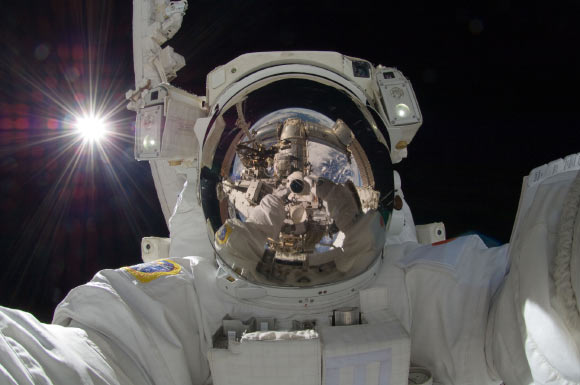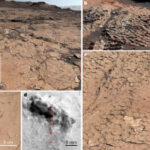But our body can eventually replenish them back on Earth with the help of bone marrow fat, according to new research.
JAXA astronaut Aki Hoshide, ISS Expedition 32 flight engineer, taking a space selfie during extravehicular activity on September 5, 2012, with the Sun behind him. Image credit: NASA.
“We found that astronauts had significantly less fat in their bone marrow about a month after returning to Earth,” said Professor Guy Trudel, a researcher at the Ottawa Hospital and the University of Ottawa.
“We think the body is using this fat to help replace red blood cells and rebuild bone that has been lost during space travel.”
This study builds on the team’s previous research which showed that during space travel, astronauts’ bodies destroyed 54% more red blood cells than they normally would on Earth, resulting in what is known as space anemia.
“Thankfully, anemia isn’t a problem in space when your body is weightless, but when landing on Earth and potentially on other planets or moons with gravity, anemia would affect energy, endurance, and strength and could threaten mission objectives,” Professor Trudel said.
“If we can find out exactly what’s controlling this anemia, we might be able to improve prevention and treatment.”
In the new research, Professor Trudel and colleagues analyzed MRI scans of the bone marrow of 14 astronauts at multiple time points before and after a six-month mission at the International Space Station.
They found a 4.2% decrease in bone marrow fat about a month after returning to Earth.
This gradually returned to normal levels and was closely associated with increased production of red blood cells and restoration of bone.
“Since red blood cells are made in the bone marrow and bone cells surround the bone marrow, it makes sense that the body would use up the local bone marrow fat as a source of energy to fuel red blood cell and bone production,” Professor Trudel said.
“We look forward to investigating this further in various clinical conditions on Earth.”
The authors also suggest that younger astronauts may have an increased ability to harness the energy from bone marrow fat, and that female astronauts’ bone marrow fat increased more than expected after a year.
“Our research could also shed light on diseases such as osteoporosis, metabolic syndrome, aging and cancer, which are associated with increases in bone marrow fat,” Professor Trudel said.
The findings were published in the journal Nature Communications.
_____
T. Liu et al. 2023. Bone marrow adiposity modulation after long duration spaceflight in astronauts. Nat Commun 14, 4799; doi: 10.1038/s41467-023-40572-8




